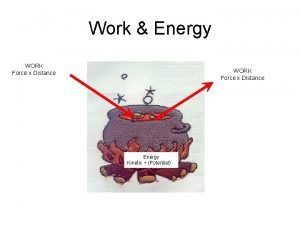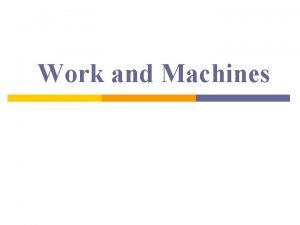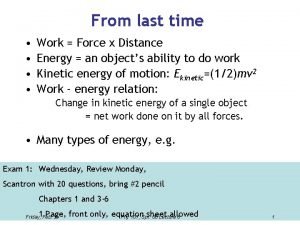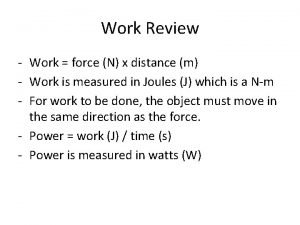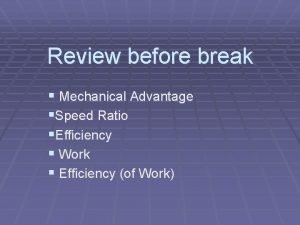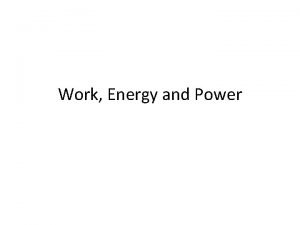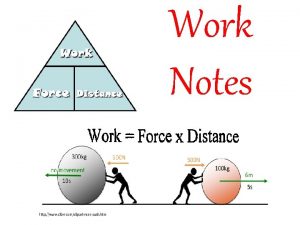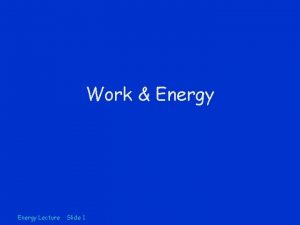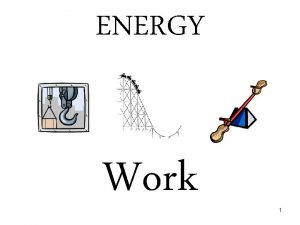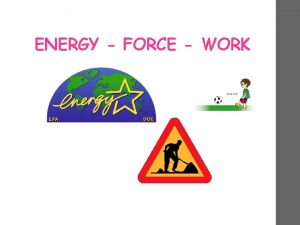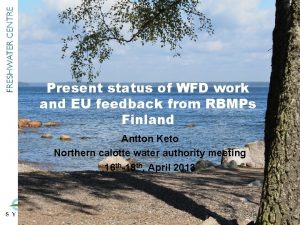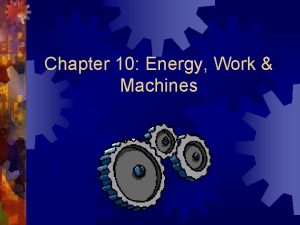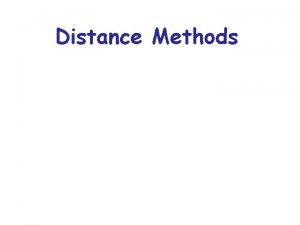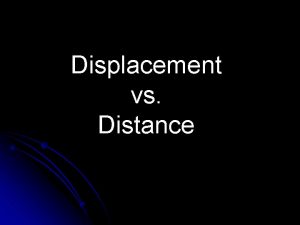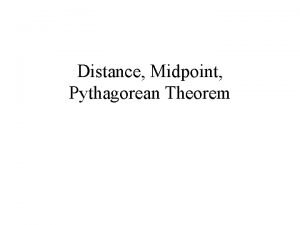Energy Chapter 9 Work Force x distance WFd















- Slides: 15

Energy Chapter 9

Work = Force x distance W=Fd Is done when a force acts on an object and the object moves in the direction of the force. Involves a transfer of energy between object and surroundings Force (Newtons) x distance (meters) = N*m = Joule (J) KJ – Kilojoules - thousands of joules MJ – megajoule – millions of joules Work done against another force, movement against the influence of an opposing force (gravity or friction) Work done to change the speed (accelerating, decelerating)

Power – how fast the work is being done Walking up the stairs carrying 11 kg weight or running up the stairs Power = work done time interval Twice the power = work in half the time not necessarily twice as much work. Power = Work time = Joule = Watt (W) or Kilowatt (KW) second 1000 W = Kilowatt (KW) 1, 000 W = Megawatt (MW)

Mechanical Energy – energy due to the position of something or the movement of something. Kinetic Energy – energy of motion Potential Energy – energy that is stored

Potential Energy (PE) Elastic Potential Energy – energy in a stretched or compressed spring, band Bow Rubber band Chemical Energy – energy from chemical reaction Fossil fuels Batteries Food Gravitational Potential Energy – energy released when gravity acts on an object. Water in reservoir Ram of pile driver PE = mgh = mass * gravity * height

Kinetic Energy of Motion Equal to the work required to bring it to speed from rest or work done while being brought to rest. Kinetic Energy = ½ mass * Speed 2 KE = ½ mv 2 KE = net force * Distance KE = Fd = ½ mv 2

Work-Energy Theorem Whenever work is done, energy changes. Work = D KE No change in energy – no work being done. Remember KE depends on speed 2 Brakes can only supply a maximum friction no matter what the speed of the vehicle Car moving twice the speed of another requires 4 times as much work to stop it. Kinetic energy – take many forms Heat, sound, electricity, light

Conservation of Energy cannot be created or destroyed, it is transformed from one from into another. The total amount of energy never changes.

Machines Device used to multiply forces or change the direction of forces. Transfers energy from one place to another or transforms it from one form into another.

Levers and pulley Levers – bar that turns about a fixed point (fulcrum) Work input = work output or (force * distance)in = (force * distance)out mechanical advantage - Ratio of output force to input force Pulley – change the direction of a force or multiply a force Mechanical advantage is same as the number of strands of ropes that support the load.

Inclined planes Ramp used to slide objects up rather than lifting. Sliding an object requires less force than just lifting it.

Efficiency 100% efficiency – work input all transferred to work output No machine is 100% efficient Some energy is transformed to molecular kinetic energy (heat) Ratio of useful energy output to total energy input. Percentage of work input converted to work output Efficiency = useful work output total work input or actual mechanical advantage theoretical mechanical advantage

Energy for Life Bodies are machines Convert energy in food to energy for warmth, body function, muscle function, etc. release carbon dioxide. Plants use process of photosynthesis and absorb energy (sunlight) to use carbon dioxide and water to create sugar and oxygen.

Energy Sources Solar Power – sunlight transformed into electricity by photovoltaic cells. Wind – energy of wind can turn generator turbines in windmills Fuel Cells – hydrogen and oxygen gas are compressed to produce water and electric current. Nuclear – Geothermal – energy stored in hot water/steam generated by volcanic activity Heated water near surface provides steam to run turbogenerators. Iceland, New Zealand, Japan, Hawaii

Works Cited http: //slideplayer. com/1455519/4/images/1/Work+In+physics%2 C+work+has+a+very+specific+meaning. +In+physics% 2 C+work+represents+a+measurable+change+in+a+system%2 C+caused+by+a+force. . jpg https: //i 1. wp. com/www. aplustopper. com/wp-content/uploads/2016/11/power-1. gif? resize=522%2 C 197&ssl=1 https: //media 1. britannica. com/eb-media/22/166422 -004 -F 5 DE 3 C 2 F. jpg http: //slideplayer. com/5697843/18/images/8/Examples+of+Potential+Energy%3 A. jpg http: //slideplayer. com/10786285/38/images/4/Kinetic+Energy+The+energy+of+motion+that+is+released+from+stored+ energy. +Examples%3 A+What+similarities+do+you+notice+about+all+these+examples. jpg https: //www. online-sciences. com/wp-content/uploads/2017/03/Law-of-conservation-of-energy-1 -300 x 179. png https: //sites. google. com/site/swansen 304/_/rsrc/1468867341905/simplemachinesall. jpg https: //userscontent 2. emaze. com/images/b 84 e 7 ccc-e 0 a 4 -4 dbc-83 d 2017 cdecad 528/5 e 70 a 0 c 02 f 3 f 30 d 262 c 3 b 2 a 54 b 0 d 1 d 48. jpg http: //philschatz. com/physics-book/resources/Figure_10_05_04 a. jpg http: //www. edinformatics. com/math_science/simple_machines/Inclined_plane. gif https: //dr 282 zn 36 sxxg. cloudfront. net/datastreams/fd%3 A 3 a 8 b 868 ced 61 d 4 b 45 f 5 c 32 edabc 96 e 70 bb 5 f 8878 a 26 a 806286 eed 92 c%2 BIMAGE_THUMB_POSTCARD_TINY% 2 BIMAGE_THUMB_POSTCARD_TINY. 1 http: //stem. hcoe. net/wp-content/uploads/3. png https: //www. fueleconomy. gov/feg/fc_pics/fuel_cell_still. gif
 Wfd reporting guidance 2022
Wfd reporting guidance 2022 Work is force x distance
Work is force x distance Work equals force times distance
Work equals force times distance Work=force x distance
Work=force x distance Energy = force x distance
Energy = force x distance Work= force x distance
Work= force x distance Chapter 4 work and energy section 1 work and machines
Chapter 4 work and energy section 1 work and machines Energy times distance
Energy times distance Work energy theorem for a variable force class 11
Work energy theorem for a variable force class 11 Work energy theorem
Work energy theorem Chemical potential energy images
Chemical potential energy images Energy energy transfer and general energy analysis
Energy energy transfer and general energy analysis Energy energy transfer and general energy analysis
Energy energy transfer and general energy analysis The ratio of input distance to output distance
The ratio of input distance to output distance A delivery truck travels 18 blocks north
A delivery truck travels 18 blocks north Efficiency equation
Efficiency equation

